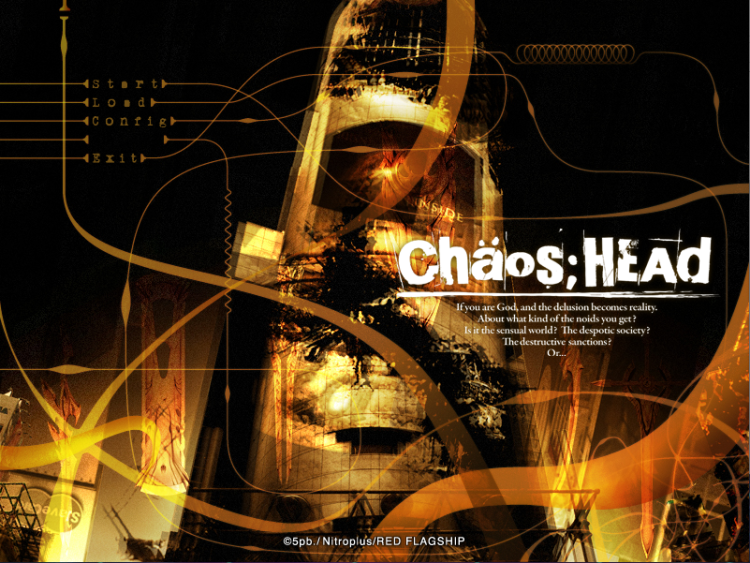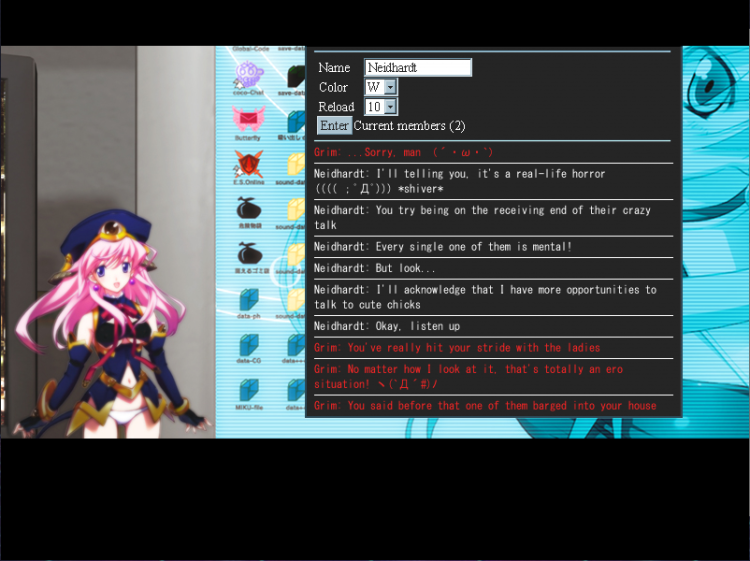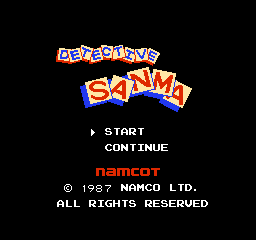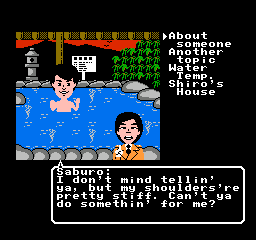
Chaos;Head, a visual novel that begins as a murder mystery before delving into some seriously uncomfortable existential horror, was released for the PC in 2008. It was effectively superseded by the multi-platform enhanced port Chaos;Head Noah one year later. As of this writing, all variants of Chaos;Head remain exclusive to Japan. While Noah contains more total content and is easier to track down, English speakers are likely to gravitate to the original, which received a complete fan translation patch some years ago. Developed by Nitroplus, Chaos;Head marks the beginning of the Science Adventure series, which of course contains the exemplary Steins;Gate. Now, the series is something of a mess to wade through: every Science Adventure installment takes place in the same universe, but each individual VN may be either explicitly or only tenuously related to the others. For instance, Steins;Gate 0 is incomprehensible to those who haven't played Steins;Gate, but Steins;Gate can certainly be played by those who have yet to experience Chaos;Head, provided the player doesn't mind missing a few passing references. Chaos;Child (which was officially localized) exists in some murkier waters: it's a "thematic sequel" to Chaos;Head with a new cast of characters but plenty of references to its predecessor. Anecdotally speaking, I went "backwards" here, playing Child first, and things went mostly smoothly. In any event, I'd be hard pressed to "recommend" folks play Chaos;Head from the get-go, due to its price, rarity, its reliance on patching, and outdated system requirements. But for those who are comfortable with tinkering with old PC games -- go for it!
The protagonist of Chaos;Head is one Takumi Nishijou. He doesn't live in a science laboratory (like Okabe of Steins;Gate) or a van (like Takuru of Chaos;Child) but instead dwells inside of a metal shipping container. Peak levels of comfy. Takumi is unquestionably a weird dude. An (occasional) high school student, antisocial outcast, an otaku, a hikikomori, the young man spends the bulk of his time immersed in a certain MMORPG whilst fantasizing about his fictional anime "waifu" Seira. Takumi can be abrasive, selfish, annoying, and downright bizarre. He's also a fascinating lead; not a stereotypical harem-possessing studmuffin nor a contrived brooding antihero, Takumi is a the very image of the alienated male. He also has a long and storied history with mental illness. Depressed and neurotic, Takumi is prone to experience brief delusions of the audiovisual variety. Perpetually paranoid, he can't shake the feeling of being watched at all times by an unknown entity.
Structurally, Chaos;Head is comprised of ten chapters plus a brief introduction and conclusion. Chapters are decently meaty in length, though not overly long; a chapter-a-day playing (or "reading") schedule suits this VN nicely. After a rather bizarre and decidedly ambiguous opening, Takumi is introduced in his metal-encased NEET cell. Skipping school and coasting along in MMO heaven, Takumi is made aware of a series of murders occurring in his native Shibuya. These kills are so brutal they practically defy comprehension, with the resulting corpses posed in a sequence of grotesque yet eye-catching arrangements. Takumi would be content to ignore said slaughter, until he's inadvertently roped into it. A mysterious online stranger, popping into an MMO chatroom, sends Takumi a photograph of an elaborately staged killing...... before it happens.

Those initial hours of gameplay are dedicated to the murder mystery itself, with Chaos;Head playing out like a classic "detective" VN the likes of which can be traced back to Portopia. Takumi finds himself (possibly?) witnessing the very murder he somehow previewed, he's forced to converse with a raggedy hard-boiled detective, he sets his sights on a plausible suspect, while he himself is declared to be the killer by an aggressive acquaintance. Takumi also befriends (loosely speaking) a group of unusual female students, each with their own troubled backstory. Meanwhile, bodies keep stacking up in the streets of Shibuya. It's all quite riveting, with ten additional questions popping up alongside each conceivable answer. And in sharp contrast to Takuru of Chaos;Child, Takumi doesn't especially want to "solve" this murder mystery. He's absolutely bewildered, terrified, and in way over his head.
And then there's a colossal bait and switch. Soon enough the "detective" element of this VN takes a backseat to the "science" element. And this "science" is pretty far removed from hard sciences. Like Steins;Gate, Chaos;Head is deep into the realm of pseudoscience technobabble, globalist conspiracies, dystopian futures, and the fragile nature of reality itself. It soon becomes apparent that Takumi isn't relegated to experiencing simple "schizophrenic" delusions. He's also capable of flipping reality and perception -- that is, what he envisions has the potential to manifest in the real world. This isn't an unlimited godlike power; it's conditional and can only be activated during very specific circumstances. Turns out Takumi's lady friends also possess similar abilities, which opens up the possibility for collective delusions, an idea that comes bundled with some interesting sociopolitical implications. Antagonists emerge, who naturally want to harness these abilities for their own nefarious ends, and the murders end up fitting into the whole dastardly "scheme" albeit in a convoluted manner. One of the great things about Steins;Gate was how the pseudoscience was built upon an altar of real science. Such conventions apply to Chaos;Head as well. The manifestation of delusions is explained using electric brain waves, binary numbers, and "blind spots" within one's visual field. The tale's heroes are additionally able to pull weapons (massive, elaborately detailed swords) from the Dirac sea, a theoretical model of particles used in "real life" physics.
As far as game flow goes, much of Chaos;Head is naturally spent reading. There are no grand "routes" that splice the game into varying pathways (though apparently these were added to Noah, with each route being dedicated to one of the female characters). However, the player can occasionally select whether Takumi is to engage in a positive delusion, negative delusion, or just proceed as normal. Such delusions are Takumi's "normal" delusions, not the "real-booting" of physical objects. The positive delusion option is represented by a moving green dot that briefly appears onscreen, negative delusions are chosen by clicking what looks like a red EKG line. Ignore both options for a few lines of dialogue and the ability to delude Takumi vanishes. Negative delusions tend to be morbid and bizarre, while positive ones are raunchy teenage fantasies. For the most part. Some of the delusions are so flaccid and weak they barely differ from the "non-option" -- one has to wonder if this element of the game was rushed in development. As a further matter, there are also some "Yes or No" questions that pop up sporadically. Though scarce, these actually alter game flow significantly. The questions are presented in a quizzical manner, but are so vague and "philosophical" that it's hard to discern proper answers. As with any visual novel, it's best to save liberally and frequently.

On to the visual presentation. First and foremost, the game is very dark. Not just in mood and ambiance -- the game is literally quite black. There's a persistent black bar across the top of the game window, the text box is black, and since Chaos;Head sports 4:3 resolution going fullscreen on a modern display will result in vertical black bars on each side. Backgrounds are detailed and numerous, highlighting the gritty aesthetics of a corrupted Shibuya. CGs are also large in number, finely crafted, and available for repeated viewings after the game wraps up. Now, most of the characters that appear onscreen are of the feminine variety. They're all adorable, but the art is a bit generic, especially when stacked up against the likes of Steins;Gate. It's like a single "cute anime girl" template was used, with some modifications to hair and eye color made here and there. For the first few hours of the game it can be tricky to decipher who's who. It should also be noted that Chaos;Head features some extremely violent imagery. The murders are either displayed in full detail or are so disturbing that they had to be relayed via text alone. Take this as a warning.
No one asked for it, but there's also an option to play the game with all female characters wearing nothing but their underwear. Supposedly this was an extra available only to those who pre-ordered the game, and my personal copy includes this feature. It's not as enticing as it sounds, for a myriad of reasons. First and foremost is the fact that every character is underage (at least in appearance even if it isn't explicitly stated). CGs remain unedited (just the standard in-game models were changed), so the lingerie-clad ladies will often "become clothed" for a brief CG and then go back to their unmentionables. This applies to most CGs at least. In some of the "positive delusions" Takumi fantasizes about a girl getting undressed in front of him -- this makes no sense if she's already been stripped. I'm fairly convinced that this whole thing was a prank by the developers anyway: halfway through the game a rotund middle-aged female investigator is introduced and she too is in her skivvies. Trolled like a boss!! In any event, the whole "lingerie" thing is silly and stupid and clashes with the game's overall mood. It can be safely ignored.
The sound design is intriguing. Chaos;Head contains some fine tunes, but makes little use of them. Much of the experience is spent listening to ambient noises (computer hums, traffic, murmurs) or flat-out dead silence. It's unsettling and often outright disorienting, highlighting Takumi's paranoia and projecting it onto the player. Such sounds are often coupled with some light first-person animation: Takumi whipping his head around to behold whatever he perceived to be "following" him, usually to be met with the sight of taunting emptiness. It's an effect not seen in many visual novels and truly elevates the game's immersion factor. As for the actual musical tracks, they're mostly subtle haunting pieces with a strong industrial bent. Add in a few upbeat songs from the fictional in-game goth punk band and a pretty competent OST emerges. The voice acting is relatively strong and about what one would expect from a VN with these production values.

Pacing is one of the game's better qualities. The chapters all feel about equal in length, each with an episodic vibe. The scenario and script are truly quite excellent, with plenty of hooks and twists and turns to keep the reader guessing. Things do get a tad overwhelming at times, there's simply quite a lot of "stuff" to juggle in one's memory while reading. And "the big twist" is oddly similar to the one in Chaos;Child (or vice versa, technically), so anyone who's experienced one of these games will see it coming in the next. Kudos to the writers for resisting the temptation to transform Takumi into a "zero to hero" character. Instead, he's perpetually tragic, his quest being reluctantly undertaken simply to put an end to suffering rather than to dramatically save the world from calamity. This is a sad story, and one that revels in its sadness. The female characters, while ever-charming, aren't especially developed unfortunately. They come and go like the wind; I'd suspect that Noah was crafted in large part to rectify this "issue." There are, of course, specific "themes" to be found embedded in the narrative. Nothing too groundbreaking, but Chaos;Head is certainly an intriguing look at how one perceives themselves vs. how they "manifest" in the minds of others. And how ideas and values can arise from dubious places and take root in our subconscious.
Chaos;Head contains three endings, oddly labeled the A, AA, and B endings. Unveiling the entire trio is somewhat frustrating. Either A or AA can be earned on one's first playthrough, based solely on how some of those aforementioned "deep" questions are answered near the journey's end. B requires one boot up a new save and replay (fast-forward) through the experience whilst activating delusions in a specific manner. It all but requires a walkthrough and the ending itself is a letdown compared to the "true" (AA) one, though it provides some additional insight into the psyches of a couple of Takumi's compatriots.
All told, Chaos;Head is quite the trip. I was actually surprised to find myself enjoying this more than both Chaos;Child and Steins;Gate 0 (the original Steins;Gate remains untouchable). As the first game in the series it feels reined in, in a good way: taut and accessible without layers of fluff and padding. While too obscure for the average gamer, visual novel fanatics would be wise to consider it, at some point or another.







